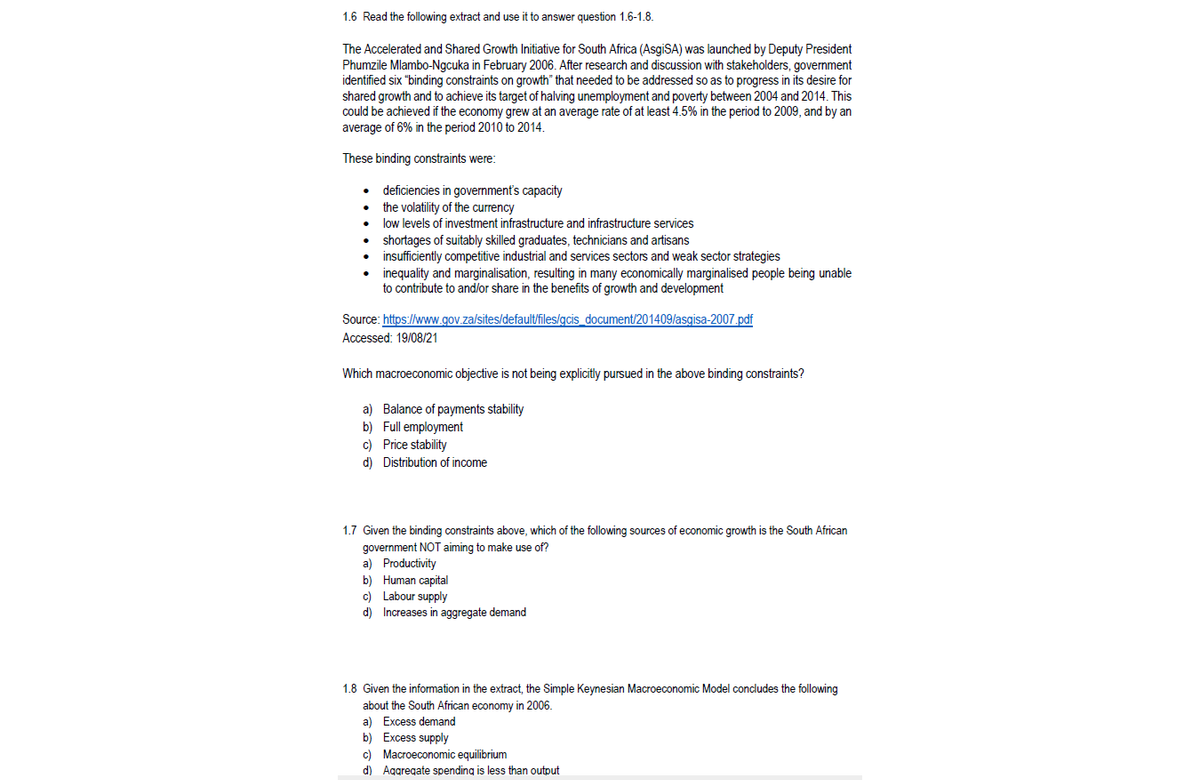Which macroeconomic objective is not being explicitly pursued in the above binding constraints? a) Balance of payments stability b) Full employment c) Price stability d) Distribution of income
Which macroeconomic objective is not being explicitly pursued in the above binding constraints? a) Balance of payments stability b) Full employment c) Price stability d) Distribution of income
Chapter3: Scarcity, Trade-offs, And Production Possibilities
Section: Chapter Questions
Problem 11P
Related questions
Question
100%

Transcribed Image Text:1.6 Read the following extract and use it to answer question 1.6-1.8.
The Accelerated and Shared Growth Initiative for South Africa (AsgiSA) was launched by Deputy President
Phumzile Mlambo-Ngcuka in February 2006. After research and discussion with stakeholders, government
identified six "binding constraints on growth" that needed to be addressed so as to progress in its desire for
shared growth and to achieve its target of halving unemployment and poverty between 2004 and 2014. This
could be achieved if the economy grew at an average rate of at least 4.5% in the period to 2009, and by an
average of 6% in the period 2010 to 2014.
These binding constraints were:
deficiencies in government's capacity
the volatility of the currency
• low levels of investment infrastructure and infrastructure services
shortages of suitably skilled graduates, technicians and artisans
insufficiently competitive industrial and services sectors and weak sector strategies
inequality and marginalisation, resulting in many economically marginalised people being unable
to contribute to and/or share in the benefits of growth and development
Source: https://www.gov.za/sites/default/files/gcis_document/201409/asgisa-2007.pdf
Accessed: 19/08/21
Which macroeconomic objective is not being explicitly pursued in the above binding constraints?
a) Balance of payments stability
b) Full employment
c) Price stability
d) Distribution of income
1.7 Given the binding constraints above, which of the following sources of economic growth is the South African
government NOT aiming to make use of?
a) Productivity
b) Human capital
c) Labour supply
d) Increases in aggregate demand
1.8 Given the information in the extract, the Simple Keynesian Macroeconomic Model condudes the following
about the South African economy in 2006.
a) Excess demand
b) Excess supply
c) Macroeconomic equilibrium
d) Aggregate spending is less than output
Expert Solution
This question has been solved!
Explore an expertly crafted, step-by-step solution for a thorough understanding of key concepts.
Step by step
Solved in 2 steps

Knowledge Booster
Learn more about
Need a deep-dive on the concept behind this application? Look no further. Learn more about this topic, economics and related others by exploring similar questions and additional content below.Recommended textbooks for you

Exploring Economics
Economics
ISBN:
9781544336329
Author:
Robert L. Sexton
Publisher:
SAGE Publications, Inc

Essentials of Economics (MindTap Course List)
Economics
ISBN:
9781337091992
Author:
N. Gregory Mankiw
Publisher:
Cengage Learning

Brief Principles of Macroeconomics (MindTap Cours…
Economics
ISBN:
9781337091985
Author:
N. Gregory Mankiw
Publisher:
Cengage Learning

Exploring Economics
Economics
ISBN:
9781544336329
Author:
Robert L. Sexton
Publisher:
SAGE Publications, Inc

Essentials of Economics (MindTap Course List)
Economics
ISBN:
9781337091992
Author:
N. Gregory Mankiw
Publisher:
Cengage Learning

Brief Principles of Macroeconomics (MindTap Cours…
Economics
ISBN:
9781337091985
Author:
N. Gregory Mankiw
Publisher:
Cengage Learning

Principles of Economics 2e
Economics
ISBN:
9781947172364
Author:
Steven A. Greenlaw; David Shapiro
Publisher:
OpenStax

Principles of Economics, 7th Edition (MindTap Cou…
Economics
ISBN:
9781285165875
Author:
N. Gregory Mankiw
Publisher:
Cengage Learning

Principles of Economics (MindTap Course List)
Economics
ISBN:
9781305585126
Author:
N. Gregory Mankiw
Publisher:
Cengage Learning